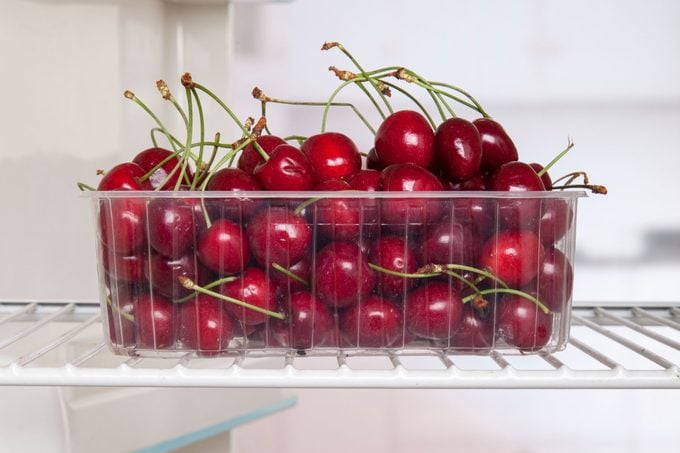Whether you'll be eating them right away or keeping them for later, here's how to store cherries so they're crisp and fresh when you need them.

How to Store Cherries in the Fridge or Freezer

From May through August, bags of cherries are widely available in grocery stores and farmers markets. Like other stone fruits, it’s hard not to stock up when they’re in season. The tiny red and golden fruits are ideal for snacking, making cherry pie, cooking them down into cherry jam or freezing them in homemade cherry ice cream. Knowing how to store cherries will ensure they don’t go bad before you get to the bottom of the bag.
How to Choose Cherries
The first step to choosing cherries is knowing how you want to use them. There are several types of cherries, all of which fall under two categories: sweet and tart. For fresh eating, look for sweet cherries like Bing, black and Rainier. Their tart counterparts—Montmorency and Morello—are best used in pies and jams.
When shopping for cherries, pay close attention to the skin. It should be taught and glossy, never dull. Fruit should be plump with no splits or wrinkles. Tart cherries however, tend to be a little softer than sweet varieties.
How to Store Cherries

What countertop doesn’t look better with the addition of a bowl full of cherries? If you want to preserve their freshness, however, we don’t recommend countertop storage. Room temperature storage results in dull-colored skins and soft fruit within a few days. Instead, store cherries uncovered in the refrigerator as soon as you bring them home. This way, they’ll stay fresh for up to a week, if not longer. Before transferring them to the refrigerator, look them over and remove any damaged fruit. Leave the stems intact until you’re ready to eat them.
When should you wash cherries?
Do not wash cherries until you’re ready to eat them. Cherries have a small crevice where the stem meets the fruit, and it’s nearly impossible to dry this area completely. Washing before storing increases the likelihood that your cherries will rot before you can eat them.
Because cherries are often treated with cover sprays to prevent fungal and insect issues, it’s best to rinse them thoroughly right before eating. A good rinse in a collander beneath a cool tap will do the trick.
Once washed, you’ll need to know how to pit cherries. Washed, pitted cherries are the first step to these delicious cherry recipes.
How to Freeze Cherries

When you’ve picked or bought far more cherries than you can consume, freezing the fruit is a great way to prolong their shelf life. When stored properly, frozen fruit is good for about eight to 12 months. Cherries can be frozen with or without pits. Keep in mind, thawed cherries will have a softer consistency than their fresh counterparts. Because of this, they’re best used for jams and other cherry desserts. To freeze cherries, follow these simple instructions:
Step 1: Remove stems and damaged cherries
Give your cherries a good once-over, and remove any that show signs of damage or mold. Remove stems.
Step 2: Line them on parchment
Line a baking sheet with parchment and spread your cherries in a single layer. If you have a glut of cherries, use several baking sheets to prevent them from freezing in clumps.
Step 3: Freeze
Place the cherries in the freezer for at least an hour.
Step 4: Transfer to labeled storage bag
Once frozen, place the cherries in a resealable freezer-safe bag and label with the date and variety.



















